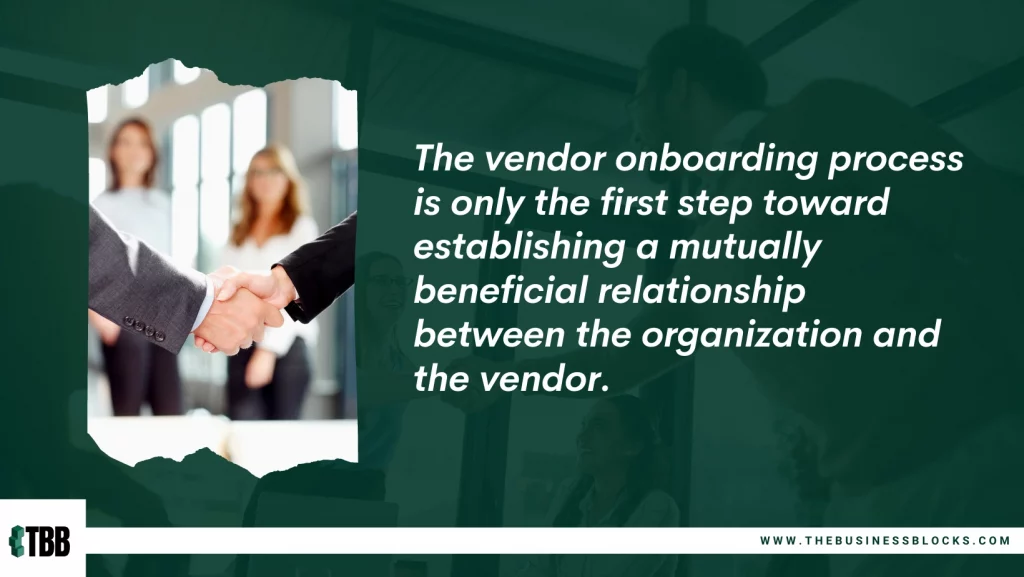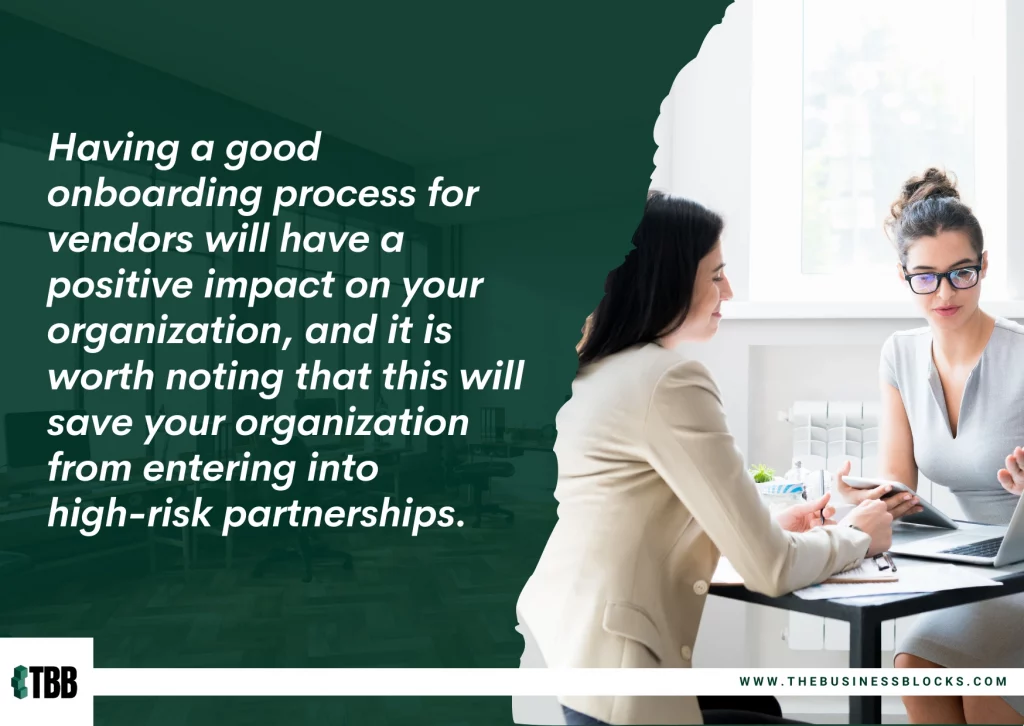It is critical to cultivate positive relationships with your vendors. Vendors play an important role in keeping your organization running smoothly. Some organizations may require only a few vendors, while others require a large number of vendors, and this is where things become complicated. Clear steps or processes for onboarding vendors may expose your company to various risks.
A vendor onboarding process will help you get off to a good start with your vendors, allowing you to work properly and smoothly. By taking care of it first, you’ll have peace of mind knowing you’ll avoid some headaches.
What Is Vendor Onboarding
Vendor onboarding gathers the information and documentation required to approve a company or vendor as a supplier, enabling your organization to transact with them. This includes purchasing goods and services and establishing payment terms. It is critical to evaluate prospective vendors and determine whether they are also in compliance with applicable laws and your company’s standards.
This is similar to employee onboarding in that new members are presented with company processes, practices, rules, regulations, and expectations. Vendors will be valuable contributors to your organization, so in addition to finding the right partners, you want them to feel the excitement and importance of partnering with you.
The vendor onboarding process is the first step toward establishing a mutually beneficial relationship between the organization and the vendor. You can set expectations for them at this point and vice versa.

The Vendor Onboarding Process
The Vendor onboarding process may consist of many steps, but here are some general ones:
1. Research
The first step in any onboarding process is to conduct research. When onboarding vendors, you should thoroughly research all available options in the market. It could come from recommendations from members of your organization, finding vendors online, or listening to sales pitches.
2. Sending Out Proposals
This is the stage when your company will send proposals to your top vendor choices, which could be three or more, depending on your preferences. The proposal should include the organization’s objectives, goals, what services or products your organization requires, and any other technical requirements that vendors must meet.
There should also be a section where you ask or request the vendor to respond formally to your proposal, indicating whether or not they can provide what your organization requires and if they can meet the requirements.
3. Comparing Vendors
You can now begin comparing once you have received responses from the vendors. You can list the benefits and drawbacks of working with each prospective vendor.
4. Risk Assessment
At this point, you must look at the big picture and identify the issues that your company may face while working with each prospective vendor. It is critical to assess the level of risk that partnering with each vendor will pose to your organization. It could be classified as high, moderate, or low risk.
5. Due Diligence
This is a crucial step. The due diligence requirement will vary, depending on the vendor’s risk level. The greater the risk, the greater the need for due diligence. First, list your company’s internal, local, and international compliance issues.
Basic information, business permits, proof of tax compliance, a good standing report, a Non-Disclosure Agreement (NDA), and other documents are all required for the due diligence process.
6. Ask for References
It is best to narrow your list of prospective vendors after evaluating them and asking for references or customer reviews. This will give you an idea of how they interact with their clients and the quality of their products or services.
7. Planning an Exit Strategy
Once you’ve decided on a vendor to work with, it’s critical to have a backup plan in place in case your relationship with the vendor breaks down. Plan how you will properly end the contract before signing it. Define the deliverables and what must be returned. It should be the same with the vendor.
It’s also critical to identify your backup vendor if things don’t go well with your first choice, so you can keep the vendor partnership going.
The exit strategy should be clearly stated in the contract.
These steps will keep you from contracting with the wrong vendors and help you find the best ones.
Benefits of a Good Vendor Onboarding
Vendor Onboarding is the first step in Vendor Management. Like with employee onboarding, the process ensures that your organization is in the best possible position to benefit both vendors and your organization. Aside from developing a positive relationship with the vendor and emphasizing their importance, the following are some of the advantages of vendor onboarding to your organization:
- Mitigate risks: Reduce risks by implementing internal policies to prospect vendors that ensure both parties comply with rules and regulations.
- Increase ROI: Increase ROI by avoiding unnecessary costs associated with tracking new vendors and properly aligning them with the organization’s goals. This reduces processing time, which leads to increased productivity and ROI.
- Improve efficiency: Processes are streamlined, reducing the time required to process and approve new vendors.
- Create stronger relationships: You can create a mutually beneficial partnership by establishing good communication and an overall smooth process.
- Track data and work process: Vendor data can be used and evaluated to improve the overall work process.
Having a good onboarding process for vendors will have a positive impact on your organization, and it is worth noting that this will save your organization from entering into high-risk partnerships, which may have a significant impact on several things, including decreasing the ROI and jeopardizing the organization’s relationship with the vendors.

17 Best Ways to Onboard a Vendor
A well-planned employee onboarding and executed vendor onboarding process will keep your organization from encountering roadblocks and costly risks. Here are the top 17 best ways to onboard a vendor, covering all aspects of the vendor onboarding process:
Evaluation
- Assess the risks and track records
You don’t want to take a high level of risk without guaranteeing a high return, so always evaluate each vendor. Track their records, get reviews, and evaluate their ability and willingness to meet the organization’s needs and requirements. Examine the product that they are currently promoting, as well as their track record in the industry.
2. Keep track of data and make decisions based on it.
Keep track of the information gathered and determine if anything needs to be addressed on the vendor side, as well as the trend for onboarded vendors and statistics. This will be extremely beneficial as you move forward with your business objectives.
3. Check the credentials and financial stability of the vendor.
Examine the history of the vendor’s credit. This will give you an indication of how well they handle their business finances and whether or not they are sustainable.
4. Make the vendors sign an ethics code.
The code of ethics will lay out the broad norms of ethics and compliance that vendors must adhere to when performing their duties. This should help the vendor realize what unethical or inappropriate behavior your company won’t allow and vice versa.
Gather Information
5. Due Diligence
This is an extremely important step. The due diligence requirement will vary, depending on the vendor’s risk level. The greater the risk, the greater the need for due diligence. This will assist you in determining whether the vendors are adhering to the existing laws and regulations.
Basic information, business permits, proof of tax compliance, a good standing report, a Non-Disclosure Agreement (NDA), and other documents are all required for the due diligence process.
6. Gather information about the vendor’s products and services.
Gather information on product specifications and, if applicable, services. Price tables, special offers, and other details about the complete product/service delivery process are available. It’s also crucial to determine whether or not there will be a return/refund process and how it will operate.
7. Collect data on payment options and terms.
Get the information on how the payment should be done and the applicable terms and conditions. It is also beneficial to learn how your vendor’s order procedure works.
8. Make the data available for internal use.
Vendor information should be available to those who need it in various areas such as accounting, finance, inventory, and other relevant departments.
9. Invest in Technology.
Investing in technology is not a waste of money. This will benefit your company by enhancing data management productivity and efficiency. You’ll also be able to protect the data you’re working with.
Building Relationships with the Vendors
10. Give Vendors a Better Offer.
It is critical to conduct research in this area, particularly to understand what the competitors are offering to vendors. This will give you an idea of which deal will likely be the best. Understand the vendors’ expectations and ensure that you will meet them halfway. One of the expectations is that they will broaden their reach and use new platforms. Make them feel important and that your organization values them.
11. Provide a Vendor Support System.
A vendor support system will encourage more vendors to work with your organization because they want help when an issue arises. You can also obtain feedback from them and vice versa, allowing both of you to improve your services.
12. Provide Inventory Management Services.
Another way to attract vendors is to provide them with an inventory management system that allows them to track the products or services they sell.
13. Make the Onboarding Process Simple.
This is important because many vendors will not sign up if the process is difficult to understand and consumes time. This will undoubtedly benefit your organization. Also, make certain that the payment process is as simple as possible. Vendor retention is difficult if they are not paid on time. This will also give your organization a good reputation, attracting more vendors.
14. Train the Vendors
Training the vendor and providing additional tips will make them feel important to your organization, which may encourage them to work harder and give their all.
15. Give Updates to the Vendors
Internal onboarding team members should not be the only ones who understand the onboarding process. Provide specific goals and timelines to your vendors, as well as access to some information or plans, so that you can manage expectations.
16. Create Plans for the Vendors
A customized plan for each vendor can be provided, outlining the organization’s strategy for assisting the vendor’s growth and assuring the vendor’s success. Follow up on their progress regularly and assure them that you will assist and that they will reap the benefits of the partnership.
17. Be Flexible
There are no two vendors alike. Always remember to remain adaptable and flexible during the vendor onboarding process. Modify each step as necessary to determine what works best for each vendor and what does not.
Summary
Onboarding vendors is a critical phase for your organization and may take time from researching, contacting, and establishing the partnership. However, with time, you will learn how to build relationships with vendors and retain them by providing quality service. Onboarding vendors can be done in a variety of ways. Because each vendor has different needs, you’ll learn which process works best for them.
Suppose you don’t have a vendor onboarding process in place. In that case, you’ll pay the price for lower productivity and efficiency and the possibility of losing vendor relationships if they don’t feel valued.
Doing your due diligence is also important because it ensures you select the right vendor for your organization’s objectives. Check if the vendors you’re considering adhere to current rules and regulations.
Keep in mind that you must remain flexible during the vendor onboarding process!

